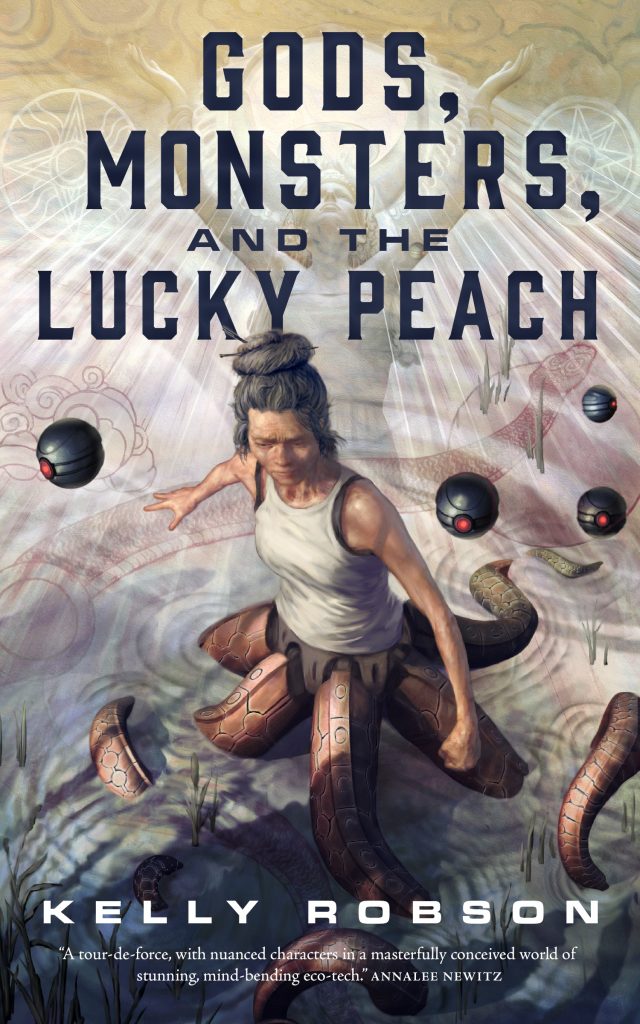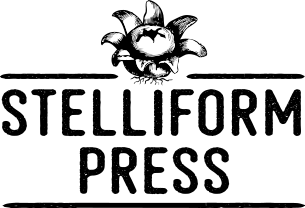Introducing the “Books We Love” Series
As part of our Internet debut, so that our future authors and and readers can get to know what to expect from the press, the Fiction and Non-Fiction editors will post reviews to the blog , describing a few books we’ve loved — both old and new. While only some of these books will be exclusively focused on the climate emergency, they will each have some elements of form or content that we’d love to see in our submissions queue. As we acquire our own titles, we will write more about Stelliform authors and their works; but until then, we will share the books we love and why we love them.

Robson’s novella, Gods Monsters and the Lucky Peach, does fit into the mandate of the press in that its technological focus is also ecological and its narrative acknowledges the ways that these two elements interact in Robson’s world.
The first thing a reader notices is the richness of that world. Robson’s futuristic Canada is divided into “habs” — habitations which include the hybrid habs of Jasper which the healthy and prosperous young people (the “fat babies”) built when they left Calgary, the gleaming Tuktoyaktuk hab on the MacKenzie Delta, and the Edmontonian ghost town. Hints of dystopia exist in the mention of Bangladesh Hell and Sudbury Hell: ecologically degraded environments which likewise degrade their inhabitants’ bodies and minds.
Robson includes details to flesh out the future ecology of Western Canada, and though there are certainly elements of dysfunction and ecological degradation, landscape is technologically managed. Meeting Minh, the protagonist, for the first time, the reader finds her pruning an ancient peach tree; this scene sets the tone for the novel in its juxtaposition of ancient agricultural technologies and the startling ways that the technological interacts with the biological in Robson’s future.
Entering into this new Calgary and understanding the way it works (and how the different parts are connected) feels easy as we are guided by Robson’s characters, who are simultaneously surprising and charming. The novella is integrated in its approach to both its setting and its characters — both are examples of biology enmeshed with tech. There is little fretting over the perfection of the human form, for example; instead of two legs, Minh has eight octopus-like tentacles. While Minh’s legs were lost to a pandemic of ringworm, her body modification clearly puts her at an advantage. Minh moves differently, but she uses her form to climb trees and intimidate bankers both. When Kiki — a tall “fat baby” whose height could have restricted her involvement in a time travelling Mesopotamian remediation project — has her legs surgically removed, her teammates are shocked and saddened over the desecration of her “perfect” healthy body, but Kiki rebuts their concern, insisting that “all [she] did was exercise autonomy over [her] health decisions.” Kiki insists that it is her right to control her own body, the way Minh and other older “plague babies” do. Robson’s book initiates readers into new perspectives on biological and technological integration, forcing us to question (as many good science fiction narratives do) the boundaries of the human.
Perhaps the greatest strength of Gods, Monsters, and the Lucky Peach is the juxtaposition that Robson makes between future Calgary and ancient Mesopotamia and the way in which shifting between these two settings provides two ways to understand both the environment and the humans that live there. Minh monitors the Mesopotamian river where she has been sent to retrieve the information needed for environmental remediation, and so through scientific processes supported by futuristic technology, understands a place that is strange to her. The Mesopotamian king, Shulgi, on the other hand, understands Minh through the myths and legends of his culture, interpreted to him not through scientific monitoring equipment, but shamanic ritual. Both of these perspectives are offered to the reader as parallel and connected understandings; and the ancient world’s ecology is a technology that parallels that of future Canada. We love that this parallel makes us think about ecology in a new way — as an exciting field to be explored, and a very important part of our future world.
